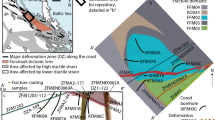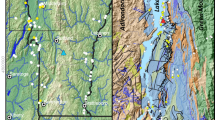Abstract
Direct dating of ductile shear zones and calculation of uplift/exhumation rates can be done using various radiometric dating techniques. But radiometric dating of shallow crustal faulting, which occurs in the crust's brittle regime, has remained difficult1,2,3,4 because the low temperatures typical of shallow crusted faults prevent the complete syntectonic mineral recrystallization that occurs in deeper faults. Both old (detrital) and newly grown (authigenic) fine-grained phyllosilicates are thus preserved in shallow fault zones and therefore their radiometric ages reflect a mixture of both mineral populations. Also, the loss of 39Ar during neutron irradiation in dating of clay minerals can produce erroneously old ages. Here we present a method of characterizing the clay populations in fault gouge, using X-ray modelling, combined with sample encapsulation, and show how it can be used to date near-surface fault activity reliably. We examine fault gouge from the Lewis thrust of the southern Canadian Rockies, which we determine to be ∼52 Myr old. This result requires the western North America stress regime to have changed from contraction to extension in only a few million years during the Eocene. We also estimate the uplift/exhumation age and sedimentary source of these rocks to be ∼172 Myr.
This is a preview of subscription content, access via your institution
Access options
Subscribe to this journal
Receive 51 print issues and online access
$199.00 per year
only $3.90 per issue
Buy this article
- Purchase on Springer Link
- Instant access to full article PDF
Prices may be subject to local taxes which are calculated during checkout


Similar content being viewed by others
References
Murphy, P. J., Briedis, J. & Peck, J. H. Dating techniques in fault investigations. Rev. Eng. Geol. 4, 153–168 (1979).
Kralik, M., Klima, K. & Riedmueller, G. Dating fault gouges. Nature 327, 315–317 (1987).
Gibbons, W. et al. Mylonite to megabreccia; tracking fault events within a transcurrent terrane boundary in Nova Scotia, Canada. Geology 24, 411–414 (1996).
Eide, E. A., Torsvik, T. H. & Andersen, T. B. Absolute dating of brittle fault movements; Late Permian and Late Jurassic extensional fault breccias in western Norway. Terra Nova 9, 135–139 (1997).
Foland, K. A., Hubacher, F. A. & Arehart, G. B. 40Ar/39Ar dating of very fine-grained samples: An encapsulated-vial procedure to overcome the problem of 39Ar recoil loss. Chem. Geol. 102, 269–276 (1992).
Smith, P. E., Evensen, N. M. & York, D. First successful 40Ar-39Ar dating of glauconites: Argon recoil in single grains of cryptocrystalline material. Geology 21, 41–44 (1993).
Dong, H., Hall, C. M., Peacor, D. R. & Halliday, A. N. Mechanisms of argon retention in clays revealed by laser 40Ar-39Ar dating. Sciences 267, 355–359 (1995).
Onstott, T. C., Mueller, C., Vrolijk, P. J. & Pevear, D. R. Laser 40Ar/39Ar microprobe analyses of fine-grained illite. Geochim. Cosmochim. Acta 61, 3851–3861 (1997).
Peaver, D. R. in Proc. 7th Int Symp. on Water-Rock Interactions (eds Kharaka, Y. K. & Maest, A. S.) 1251–1254 (Balkema, Rotterdam, 1992).
Pevear, D. R. Illite and hydrocarbon exploration. Proc. Natl. Acad. Sci. 96, 3440–3446 (1999).
Price, R. A. in Thrust and Nappe Tectonics (eds McClay, K. R. & Price, N. J.) 427–448 (Geological Society, London, 1981).
Fermor, P. Aspect of the three-dimensional structure of the Alberta Foothills and Front Ranges. Geol. Soc. Am. Bull. 111, 317–346 (1999).
Constentius, K. N. Late Paleogene extensional collapse of the Cordilleran foreland fold and thrust belt. Geol. Soc. Am. Bull. 108, 20–39 (1996).
Wiltschko, D. V. & Dorr, J. A. Timing of deformation in the overthrust belt and foreland of Idaho, Wyoming, and Utah. Am. Ass. Petrol. Geol. 67, 1304–1322 (1983).
Vrolijk, P. & van der Pluijm, B. A. Clay gouge. J. Struct. Geol. 21, 1039–1048 (1999).
Yan, Y., van der Pluijm, B. A. & Peacor, D. R. Deformation microfabrics of clay gouge, Lewis Thrust, Canada: a case for fault weakening from clay transformation. Geol. Soc. Spec Publ. (in the press).
Dong, H., Hall, C. M., Peacor, D. R., Halliday, A. N. & Pevear, D. R. Thermal 40Ar/39Ar separation of diagenetic from detrital illitic clays in Gulf Coast shales. Earth Planet. Sci. Lett. 175, 309–325 (2000).
Hall, C. M. et al. Dating of alteration episodes related to mercury mineralization in the Almadén district, Spain. Earth Planet. Sci. Lett. 148, 287–298 (1997).
Jaboyedoff, M. & Cosca, M. A. Dating incipient metamorphism using 40Ar/39Ar geochronology and XRD modeling: a case study from the Swiss Alps. Contrib. Mineral. Petrol. 135, 93–113 (1999).
Bird, P. Formation of the Rocky Mountains, western United States: a continuum computer model. Science 239, 1501–1507 (1988).
Vrolijk, P., Covey, M. C., Pevear, D. R. & Longstaffe, F. Dating clay-rich thrust faults. Geol. Soc. Am. (Abstr. Progr.) 26, 466 (1994).
Pevear, D. R. & Schuette, J. F. in Computer Applications to X-ray Diffraction Analysis of Clay Minerals (eds Reynolds, R. C. & Walker, J. R.) 19–42 (Clay Minerals Society, Boulder, CO, 1993).
Srodon, J. & Eberl, D. D. Review in Mineralogy (ed. Bailey, S. W.) 495–544 (Mineralogical Society of America, Washington, DC, 1984).
Grathoff, G. H. & Moore, D. M. Illite polytype quantification using Wildfire calculated X-ray diffraction patterns. Clay, Clay Mineral. 44, 835–842 (1996).
Reynolds, R. C. WILDFIRE: A computer program for the calculation of three-dimensional X-ray diffraction patterns for mica polytypes and their disordered variations (Hanover, New Hampshire, 1994).
Reynolds, R. C. & Reynolds, R. C. NEWMOD: A computer program for the calculation of one-dimensional diffraction patterns of mixed-layered clays. (Hanover, New Hampshire, 1996).
Acknowledgements
D. R. Pevear has retired from ExxonMobil Upstream Research Company. We thank D. R. Peacor for assistance and several Cordilleran geologists for discussion, and the National Science Foundation and ExxonMobil Upstream Research Company for support of our fault gouge research.
Author information
Authors and Affiliations
Corresponding author
Rights and permissions
About this article
Cite this article
van der Pluijm, B., Hall, C., Vrolijk, P. et al. The dating of shallow faults in the Earth's crust. Nature 412, 172–175 (2001). https://doi.org/10.1038/35084053
Received:
Accepted:
Issue Date:
DOI: https://doi.org/10.1038/35084053
This article is cited by
-
Extraction of 40Ar-39Ar ages from a multicomponent mixture: a case study from the Tatra Mountains, Poland
Clays and Clay Minerals (2022)
-
In situ Rb-Sr dating of slickenfibres in deep crystalline basement faults
Scientific Reports (2020)
-
Constraining the alteration history of a Late Cretaceous Patagonian volcaniclastic bentonite–ash–mudstone sequence using K–Ar and 40Ar/39Ar isotopes
International Journal of Earth Sciences (2017)
-
Reconciling late faulting over the whole Alpine belt: from structural analysis to geochronological constrains
Swiss Journal of Geosciences (2017)
-
Deconvoluting complex structural histories archived in brittle fault zones
Nature Communications (2016)
Comments
By submitting a comment you agree to abide by our Terms and Community Guidelines. If you find something abusive or that does not comply with our terms or guidelines please flag it as inappropriate.



